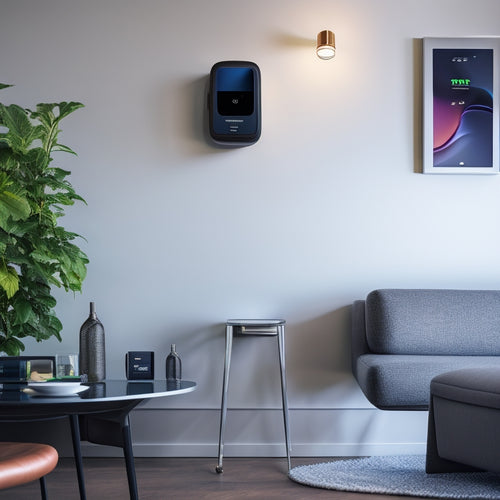10 Commercial Fleet Electrification Success Stories
Share
As you explore commercial fleet electrification, you're likely looking for inspiration from pioneers who've successfully integrated electric vehicles into their operations. You can draw from success stories like DHL's electric vans in Germany, Anheuser-Busch's electrified beer deliveries, and UPS's investment in electric vehicles. Other notable examples include FedEx's electric fleet expansion in California, IKEA's switch to electric trucks in Shanghai, and Norway's massive electric bus fleet. These pioneers have achieved significant reductions in emissions and operating costs. Take a closer look at their strategies, and you'll uncover the keys to replicating their success in your own fleet.
Key Takeaways
• DHL, Anheuser-Busch, FedEx, IKEA, and UPS have successfully electrified their commercial fleets, reducing carbon footprint and operating costs.
• Strategic planning, driver training, and data analytics are crucial for a successful fleet electrification, ensuring a seamless transition to electric vehicles.
• Investing in charging infrastructure, such as strategically placed charging stations, is vital for supporting electric fleets and reducing range anxiety.
• Setting ambitious zero-emission goals and utilizing government incentives can drive adoption and provide a competitive advantage in the market.
• Norway's electric bus fleet serves as a model for successful commercial fleet electrification, with over 1,000 electric buses and 1,500+ public charging points.
DHL Deploys Electric Vans in Germany
In a move to reduce its carbon footprint, DHL has introduced a fleet of electric vans in Germany, marking a significant step towards electrifying its last-mile delivery operations.
As you navigate the German infrastructure, you'll notice that DHL's electric vans are tackling the logistical challenges head-on. With a focus on reducing emissions, DHL is leveraging Germany's existing charging infrastructure to power its electric fleet.
You'll find that the strategic placement of charging stations has been important in minimizing downtime and maximizing delivery efficiency. By overcoming these logistical hurdles, DHL is paving the way for a more sustainable future in the logistics industry.
As you explore DHL's electrification journey, you'll see that the German infrastructure is well-equipped to support the shift to electric vehicles.
Anheuser-Busch Electrifies Beer Deliveries
As you explore Anheuser-Busch's efforts to electrify their beer deliveries, you'll notice the company's commitment to reducing its environmental footprint.
By incorporating electric trucks into their fleet, Anheuser-Busch isn't only minimizing its carbon emissions but also setting a new standard for sustainable logistics.
You'll see how these electric trucks in action are making a significant impact, achieving zero-emission deliveries that benefit both the environment and the community.
Electric Trucks in Action
Anheuser-Busch, the iconic brewing company, has successfully integrated electric trucks into its delivery fleet, introducing a cleaner, quieter, and more sustainable way to transport beer to thirsty customers.
You're now part of a pioneering effort that's redefining highway hauling. By adopting electric trucks, you're reducing your carbon footprint and operating costs.
City logistics become more efficient with quieter, zero-emission deliveries. Rural routes are also within reach, thanks to advanced fuel cells and optimized fleet management.
As you navigate this new territory, driver training programs guarantee a seamless shift. With electric trucks in action, you're not only transporting beer but also paving the way for a more sustainable future.
Zero Emission Deliveries
Twenty-five of Anheuser-Busch's beer delivery trucks are now rolling out of the brewery gates without a single emission, thanks to the company's bold electrification initiative. As you explore the world of commercial fleet electrification, you'll find that Anheuser-Busch is leading the charge towards a more sustainable future.
This effort is part of the company's commitment to reducing its carbon footprint and achieving its goal of 100% renewable electricity by 2025. By partnering with the Clean Cities Coalition, Anheuser-Busch is helping to create a cleaner, healthier environment for our communities.
Here are some key benefits of Anheuser-Busch's electrification initiative:
- Reduced greenhouse gas emissions
- Lower operating costs
- Improved air quality
- Enhanced brand reputation
- Compliance with increasingly stringent emissions regulations
FedEx Expands Electric Fleet in California
As you explore FedEx's electric fleet expansion in California, you'll notice a strategic rollout of electric vehicles, carefully prepared infrastructure, and a well-planned fleet conversion strategy.
These key aspects have enabled FedEx to successfully integrate electric vehicles into their operations, reducing emissions and operating costs.
Electric Vehicle Rollout
When contemplating your own electric vehicle rollout, it's crucial to focus on fleet readiness. You'll need to evaluate your current fleet operations, identify suitable routes for electric vehicles, and develop a plan for charging infrastructure.
Here are key factors to keep in mind for a successful rollout:
-
Vehicle incentives: Utilize government and state programs to offset the higher upfront cost of electric vehicles.
-
Fleet readiness: Evaluate your current fleet operations and identify areas for improvement.
-
Route optimization: Identify appropriate routes for electric vehicles based on range and charging infrastructure.
-
Charging infrastructure: Create a plan for charging infrastructure, including depot and en-route charging.
-
Data analysis: Monitor and analyze data to optimize your electric vehicle fleet's performance.
California Infrastructure Prep
To support its electric fleet expansion in California, FedEx has invested heavily in building out its charging infrastructure, including the installation of high-power charging stations at its distribution hubs.
As you prepare for your own fleet's electrification, you'll need to prioritize California readiness by making sure your infrastructure can support the increased demand. This means investing in grid capacity upgrades and expanding your charging networks. Fortunately, state incentives are available to help offset the costs of infrastructure investment.
Fleet Conversion Strategy
You'll need a well-structured fleet conversion strategy to successfully electrify your California-based fleet, and FedEx's experience serves as a valuable model.
To replicate their success, focus on the following key elements:
-
Fleet Analysis: Assess your fleet's current operations, including vehicle usage and routes.
-
Vehicle Selection: Choose electric vehicles that meet your fleet's specific needs and duty cycles.
-
Infrastructure Assessment: Evaluate your charging infrastructure and make certain it can support your electrified fleet.
-
Cost Modeling: Develop a detailed cost model to understand the total cost of ownership for your electric vehicles.
-
Route Optimization and Driver Training: Optimize routes for electric vehicles and provide drivers with training on their operation and maintenance.
IKEA Switches to Electric Trucks in Shanghai
IKEA has successfully replaced its diesel-powered truck fleet with electric trucks in Shanghai, marking a significant milestone in its efforts to reduce carbon emissions and minimize environmental impact. As you navigate China's infrastructure, you'll notice that Shanghai's traffic congestion can be a major logistics challenge. However, IKEA's switch to electric trucks has helped mitigate this issue while contributing to the city's green initiatives.
| Electric Truck Benefits | Shanghai's Traffic | Logistics Impact |
|---|---|---|
| 75% reduction in CO2 emissions | Reduced congestion | Increased delivery efficiency |
| 50% lower operating costs | Improved air quality | Enhanced customer satisfaction |
| Quieter and smoother operation | Increased driver comfort | Improved supply chain reliability |
UPS Invests in Electric Vehicle Fleet
As you explore UPS's investment in electric vehicles, you'll notice a strategic rollout of its EV fleet, meticulously planned to guarantee seamless deployment.
You'll see how the company's charging infrastructure plan supports its growing fleet of electric vehicles.
EV Fleet Deployment
In a major commitment to reducing its carbon footprint, UPS has invested heavily in electric vehicle technology, deploying a fleet of EVs that will significantly decrease greenhouse gas emissions from its delivery operations.
As you start on your own EV fleet deployment journey, it's crucial to take into account the following key factors:
-
Fleet Management: Develop a thorough strategy for managing your EV fleet, including route optimization and vehicle allocation.
-
Vehicle Selection: Choose EVs that meet your specific operational requirements, considering factors like range, payload capacity, and charging time.
-
Total Cost of Ownership: Calculate the overall cost of EV ownership, including purchase price, fuel savings, and maintenance costs.
-
Driver Training: Provide in-depth training for drivers to guarantee a smooth shift to EVs.
-
Data Analytics: Leverage data analytics to monitor and optimize your EV fleet's performance, identifying areas for improvement.
Charging Infrastructure Plan
Develop a thorough charging infrastructure plan that supports your fleet's unique needs, considering factors like charger type, installation location, and network connectivity to guarantee seamless EV operations.
To guarantee a successful rollout, consider the following key aspects:
| Infrastructure Aspect | Key Considerations | Benefits |
| Grid Expansion | Upgrade existing grid capacity to support increased energy demand | Increased power availability |
| Station Placement | Strategically place charging stations for convenient access | Reduced downtime, increased productivity |
| Load Management | Implement smart charging systems to manage energy distribution | Optimized energy usage, reduced peak demand |
Zero Emission Goals
You're likely aiming to decrease your fleet's carbon footprint by setting ambitious zero-emission goals, just like UPS, which has invested heavily in its electric vehicle fleet to minimize environmental impact.
To achieve this, you'll need to take into account the financial implications of shifting to electric vehicles. Fortunately, there are incentives to help offset the costs. Take into account the following:
-
Government incentives, such as tax credits or rebates, can help reduce the upfront cost of electric vehicles.
-
Carbon pricing mechanisms can provide a revenue stream to offset the costs of electrification.
-
Lower operating costs, such as reduced fuel and maintenance expenses, can also help justify the investment.
-
Access to restricted traffic zones or low-emission zones can provide a competitive advantage.
-
Brand reputation and customer loyalty can be enhanced by committing to a zero-emission fleet.
Electric Buses Power Public Transit in Norway
Norway's commitment to sustainable transportation is evident in its widespread adoption of electric buses, which now power a significant portion of the country's public transit systems. You'll notice that electric buses have become a common sight in Norwegian cities, thanks to the government's incentives and investments in charging infrastructure. This shift has not only reduced emissions but also improved the passenger experience.
| Category | Norway's Electric Bus Fleet |
|---|---|
| Number of Buses | Over 1,000 electric buses in operation |
| Charging Infrastructure | 1,500+ public charging points across the country |
| Environmental Impact | 75% reduction in CO2 emissions from public transit |
| Energy Efficiency | 3-4 times more energy-efficient than diesel buses |
As you explore Norway's electric bus network, you'll see how the country's infrastructure, city planning, and route optimization have all played an essential role in its success.
Coca-Cola's Electric Truck Fleet in USA
You're about to learn from Coca-Cola's successful electrification of their truck fleet in the USA.
Coca-Cola has electrified its truck fleet in the USA, deploying over 30 electric vehicles to serve customers in major cities like New York and Los Angeles. This move showcases the company's commitment to reducing its carbon footprint.
Here are some key benefits of Coca-Cola's electric truck fleet:
- Reduced greenhouse gas emissions by up to 75%
- Lower operating costs due to reduced fuel consumption
- Eligibility for Coca Cola Incentives, such as tax credits and grants
- Contribution to Fleet Expansion, with plans to increase the electric fleet size
- Compliance with stringent emissions regulations in key cities
Electric Garbage Trucks Clean Up Chicago
By 2022, the city of Chicago had integrated 20 electric garbage trucks into its fleet, reducing greenhouse gas emissions and noise pollution in residential areas. As you consider converting your own fleet to electric, you may wonder about the benefits. Let's break it down:
| Metric | Electric Garbage Trucks | Diesel Garbage Trucks |
|---|---|---|
| Emissions (tons CO2e/year) | 143 | 440 |
| Noise Level (dB) | 40 | 80 |
| Operating Cost (¢/mile) | 12 | 25 |
These electric garbage trucks have not only reduced emissions and noise pollution but also lowered operating costs. Chicago's Waste Management fleet is a prime example of how electric vehicles can improve city infrastructure. By adopting electric garbage trucks, cities can create a cleaner, healthier environment for their residents.
Royal Mail's Electric Van Fleet in UK
How does the UK's Royal Mail, one of the largest postal services in the world, contribute to the country's environmental goals with its electric van fleet?
By investing in electric vehicles, Royal Mail reduces its environmental impact while maintaining its commitment to efficient mail delivery.
As part of its green initiatives, the company has introduced electric vans to its mail fleet, which aligns with UK regulations promoting sustainable transportation.
Some key benefits of Royal Mail's electric van fleet include:
- Reduced greenhouse gas emissions, supporting the UK's environmental goals
- Lower operating costs, thanks to reduced fuel consumption and minimized vehicle maintenance
- Improved fleet management, with real-time monitoring and optimized route planning
- Enhanced customer satisfaction, with quieter and cleaner operations
- Compliance with UK regulations, ensuring a sustainable future for postal services
Electric Delivery Trucks in Japan's Cities
In Japan's densely populated cities, logistics companies are increasingly deploying electric delivery trucks to reduce emissions and noise pollution while maneuvering through narrow streets and alleys.
You're witnessing a significant shift towards sustainable urban logistics. Japanese regulations, such as the 'Low Emission Zone' ordinance, are driving this change by incentivizing eco-friendly transportation solutions.
As you navigate Japan's urban landscapes, you'll notice more electric trucks making deliveries, reducing congestion and emissions. The Japanese government's commitment to reducing greenhouse gas emissions by 80% by 2050 is also a key driver.
With electric trucks, you can expect quieter, cleaner, and more efficient urban logistics operations. This trend is expected to continue, shaping the future of urban logistics in Japan.
Frequently Asked Questions
How Do Electric Vehicles Reduce Operating Costs for Commercial Fleets?
You'll reduce operating costs by switching to electric vehicles, which offer lower maintenance due to fewer moving parts and achieve better fuel efficiency, resulting in significant savings on energy costs and reduced downtime.
What Are the Main Challenges in Charging Large Electric Fleets?
As you venture into the uncharted territory of large-scale EV adoption, you'll encounter challenges like maneuvering through a labyrinth - you'll need to overcome limited charging infrastructure, power grid constraints, and guarantee seamless fleet management and vehicle compatibility.
Are Electric Vehicles Suitable for Long-Distance Commercial Transportation?
When you consider electric vehicles for long-distance commercial transportation, you'll need to weigh route optimization strategies to minimize charging stops, while also mitigating driver fatigue with regular breaks, to guarantee efficient and safe operations.
How Do Government Incentives Support Commercial Fleet Electrification?
You can leverage government incentives to accelerate commercial fleet electrification by claiming tax credits for EV purchases and benefiting from regulatory exemptions, reducing operational costs and environmental impact.
Can Electric Vehicles Handle Heavy Payloads and Tow Capacities?
You'll be pleased to know that electric vehicles can indeed handle heavy payloads and tow capacities, thanks to advancements in battery durability and payload optimization, ensuring reliable performance in demanding applications.
Related Posts
-

7 Best EV Battery Health Trackers for Homeowners
You can maximize your electric vehicle's performance and lifespan by leveraging advanced battery health trackers that...
-

Why Transform Human Waste Into Garden Gold?
By changing human waste into garden gold, you'll reduce waste management costs, support sustainable agriculture, and ...
-

Gamify Your Home's Energy Generation and Savings
You're taking the next step in optimizing your home's energy generation and savings by utilizing the power of gamific...


